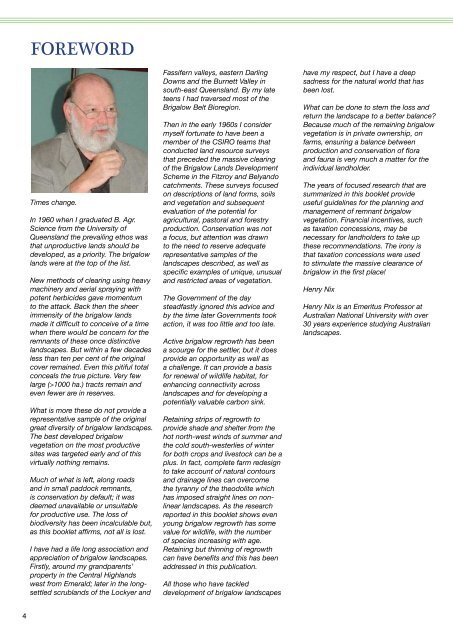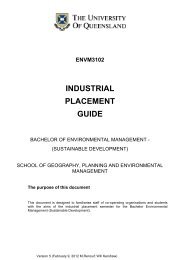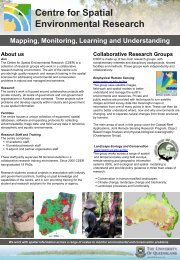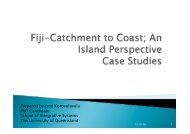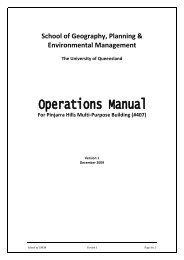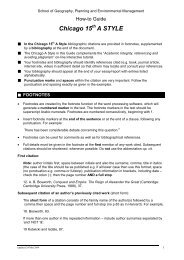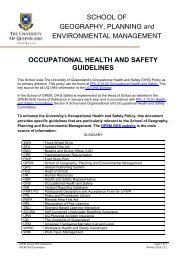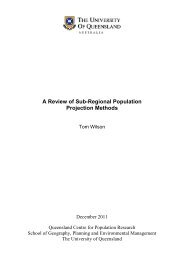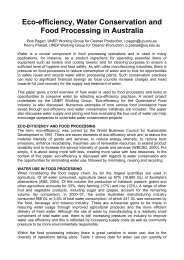Conserving Biodiversity in Brigalow Regrowth - School of ...
Conserving Biodiversity in Brigalow Regrowth - School of ...
Conserving Biodiversity in Brigalow Regrowth - School of ...
Create successful ePaper yourself
Turn your PDF publications into a flip-book with our unique Google optimized e-Paper software.
Foreword<br />
Times change.<br />
In 1960 when I graduated B. Agr.<br />
Science from the University <strong>of</strong><br />
Queensland the prevail<strong>in</strong>g ethos was<br />
that unproductive lands should be<br />
developed, as a priority. The brigalow<br />
lands were at the top <strong>of</strong> the list.<br />
New methods <strong>of</strong> clear<strong>in</strong>g us<strong>in</strong>g heavy<br />
mach<strong>in</strong>ery and aerial spray<strong>in</strong>g with<br />
potent herbicides gave momentum<br />
to the attack. Back then the sheer<br />
immensity <strong>of</strong> the brigalow lands<br />
made it difficult to conceive <strong>of</strong> a time<br />
when there would be concern for the<br />
remnants <strong>of</strong> these once dist<strong>in</strong>ctive<br />
landscapes. But with<strong>in</strong> a few decades<br />
less than ten per cent <strong>of</strong> the orig<strong>in</strong>al<br />
cover rema<strong>in</strong>ed. Even this pitiful total<br />
conceals the true picture. Very few<br />
large (>1000 ha.) tracts rema<strong>in</strong> and<br />
even fewer are <strong>in</strong> reserves.<br />
What is more these do not provide a<br />
representative sample <strong>of</strong> the orig<strong>in</strong>al<br />
great diversity <strong>of</strong> brigalow landscapes.<br />
The best developed brigalow<br />
vegetation on the most productive<br />
sites was targeted early and <strong>of</strong> this<br />
virtually noth<strong>in</strong>g rema<strong>in</strong>s.<br />
Much <strong>of</strong> what is left, along roads<br />
and <strong>in</strong> small paddock remnants,<br />
is conservation by default; it was<br />
deemed unavailable or unsuitable<br />
for productive use. The loss <strong>of</strong><br />
biodiversity has been <strong>in</strong>calculable but,<br />
as this booklet affirms, not all is lost.<br />
I have had a life long association and<br />
appreciation <strong>of</strong> brigalow landscapes.<br />
Firstly, around my grandparents’<br />
property <strong>in</strong> the Central Highlands<br />
west from Emerald; later <strong>in</strong> the longsettled<br />
scrublands <strong>of</strong> the Lockyer and<br />
Fassifern valleys, eastern Darl<strong>in</strong>g<br />
Downs and the Burnett Valley <strong>in</strong><br />
south-east Queensland. By my late<br />
teens I had traversed most <strong>of</strong> the<br />
<strong>Brigalow</strong> Belt Bioregion.<br />
Then <strong>in</strong> the early 1960s I consider<br />
myself fortunate to have been a<br />
member <strong>of</strong> the CSIRO teams that<br />
conducted land resource surveys<br />
that preceded the massive clear<strong>in</strong>g<br />
<strong>of</strong> the <strong>Brigalow</strong> Lands Development<br />
Scheme <strong>in</strong> the Fitzroy and Belyando<br />
catchments. These surveys focused<br />
on descriptions <strong>of</strong> land forms, soils<br />
and vegetation and subsequent<br />
evaluation <strong>of</strong> the potential for<br />
agricultural, pastoral and forestry<br />
production. Conservation was not<br />
a focus, but attention was drawn<br />
to the need to reserve adequate<br />
representative samples <strong>of</strong> the<br />
landscapes described, as well as<br />
specific examples <strong>of</strong> unique, unusual<br />
and restricted areas <strong>of</strong> vegetation.<br />
The Government <strong>of</strong> the day<br />
steadfastly ignored this advice and<br />
by the time later Governments took<br />
action, it was too little and too late.<br />
Active brigalow regrowth has been<br />
a scourge for the settler, but it does<br />
provide an opportunity as well as<br />
a challenge. It can provide a basis<br />
for renewal <strong>of</strong> wildlife habitat, for<br />
enhanc<strong>in</strong>g connectivity across<br />
landscapes and for develop<strong>in</strong>g a<br />
potentially valuable carbon s<strong>in</strong>k.<br />
Reta<strong>in</strong><strong>in</strong>g strips <strong>of</strong> regrowth to<br />
provide shade and shelter from the<br />
hot north-west w<strong>in</strong>ds <strong>of</strong> summer and<br />
the cold south-westerlies <strong>of</strong> w<strong>in</strong>ter<br />
for both crops and livestock can be a<br />
plus. In fact, complete farm redesign<br />
to take account <strong>of</strong> natural contours<br />
and dra<strong>in</strong>age l<strong>in</strong>es can overcome<br />
the tyranny <strong>of</strong> the theodolite which<br />
has imposed straight l<strong>in</strong>es on nonl<strong>in</strong>ear<br />
landscapes. As the research<br />
reported <strong>in</strong> this booklet shows even<br />
young brigalow regrowth has some<br />
value for wildlife, with the number<br />
<strong>of</strong> species <strong>in</strong>creas<strong>in</strong>g with age.<br />
Reta<strong>in</strong><strong>in</strong>g but th<strong>in</strong>n<strong>in</strong>g <strong>of</strong> regrowth<br />
can have benefits and this has been<br />
addressed <strong>in</strong> this publication.<br />
All those who have tackled<br />
development <strong>of</strong> brigalow landscapes<br />
have my respect, but I have a deep<br />
sadness for the natural world that has<br />
been lost.<br />
What can be done to stem the loss and<br />
return the landscape to a better balance?<br />
Because much <strong>of</strong> the rema<strong>in</strong><strong>in</strong>g brigalow<br />
vegetation is <strong>in</strong> private ownership, on<br />
farms, ensur<strong>in</strong>g a balance between<br />
production and conservation <strong>of</strong> flora<br />
and fauna is very much a matter for the<br />
<strong>in</strong>dividual landholder.<br />
The years <strong>of</strong> focused research that are<br />
summarized <strong>in</strong> this booklet provide<br />
useful guidel<strong>in</strong>es for the plann<strong>in</strong>g and<br />
management <strong>of</strong> remnant brigalow<br />
vegetation. F<strong>in</strong>ancial <strong>in</strong>centives, such<br />
as taxation concessions, may be<br />
necessary for landholders to take up<br />
these recommendations. The irony is<br />
that taxation concessions were used<br />
to stimulate the massive clearance <strong>of</strong><br />
brigalow <strong>in</strong> the first place!<br />
Henry Nix<br />
Henry Nix is an Emeritus Pr<strong>of</strong>essor at<br />
Australian National University with over<br />
30 years experience study<strong>in</strong>g Australian<br />
landscapes.<br />
4


